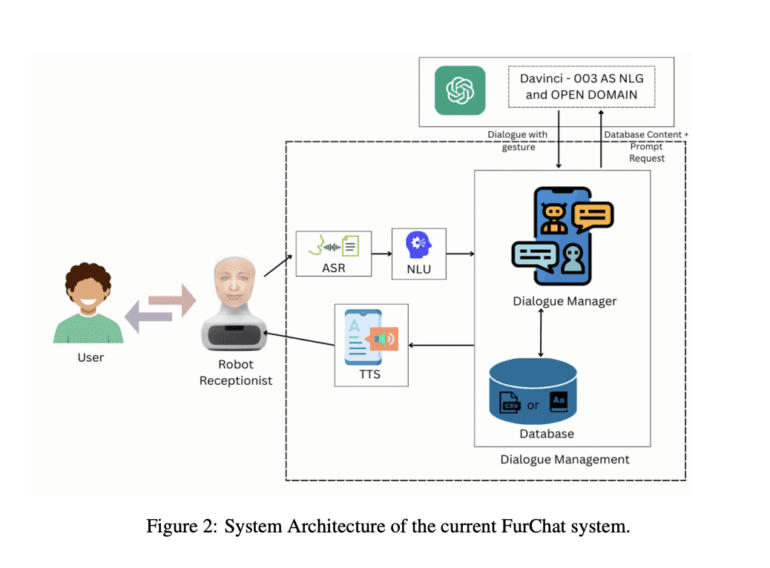TL;DR:
- FurChat, a pioneering AI robot assistant, combines generative AI and robotics to facilitate real-world interactions.
- Developed by Alana AI and Heriot-Watt University, FurChat matches user queries with specific information sources, making it a valuable tool for front desk representatives in airports and businesses.
- While challenges of human-robot interaction persist, FurChat’s potential impact is undeniable.
- The FurChat system combines GPT-3.5 with an animated robot, setting it apart as a versatile conversational agent.
- Preliminary results from the UK National Robotarium indicate FurChat’s effectiveness in communicating and providing accurate information.
- Future plans involve deploying similar AI robots in various public spaces, marking a significant step towards enhanced human-AI collaboration.
Main AI News:
In the ever-evolving landscape of artificial intelligence, groundbreaking innovations are continually reshaping the way we interact with technology. In a recent development, Alana AI and Heriot-Watt University researchers have unveiled FurChat, a chatbot that seamlessly fuses generative artificial intelligence with robotics. This innovative AI robot has the potential to revolutionize various sectors, including airports, businesses, and beyond, by matching user inquiries with specific information sources, such as company files.
The integration of chatbots into company websites has become increasingly commonplace, but the transition to real-world settings presents unique challenges. Overcoming the awkwardness of human-robot interactions and the limitations of screen-based interfaces is no small feat. However, as these developers continue to push boundaries, we must prepare for the transformative impact of AI robot assistants.
Understanding the Advancements: What Sets FurChat Apart?
To fully grasp the significance of FurChat, it’s essential to delve into what sets this AI robot apart from its counterparts. FurChat represents a groundbreaking collaboration between Heriot-Watt University and Alana AI, combining the Furhat robotic bust with OpenAI’s cutting-edge GPT-3.5. This fusion of technology aims to explore the realms of embodied AI for natural human interaction, bridging the gap between open-domain conversation and specific information sources.
Researcher Oliver Lemon elaborates on this pioneering endeavor, stating, “FurChat combines a large language model (LLM) such as ChatGPT with an animated speech-enabled robot. It is the first system that we know of which combines LLMs for both general conversation and specific information sources with automatic expressive robot animations.”
The inner workings of FurChat involve GPT-3.5, the ChatGPT large language model, generating text responses and facial expressions. These generated texts are then brought to life by the Furhat AI robot’s voice. In a real-world test at the UK National Robotarium in Scotland, the preliminary results demonstrated FurChat’s effectiveness in seamlessly communicating with users, providing accurate information, and fostering smooth interactions.
Charting the Path Forward: FurChat’s Promising Future
The team behind FurChat has ambitious plans to expand the presence of similar AI robots across public spaces, festivals, museums, and various other venues. Their mission is clear: harness recent advancements in LLMs to create more practical, user-friendly, and compelling systems that facilitate collaboration between humans, robots, and AI systems.
Oliver Lemon underscores the importance of combining vision and language for embodied agents working alongside humans, emphasizing the increasing significance of such systems in the years to come. As we witness the continued development of human-AI collaboration systems, FurChat stands as a testament to the boundless possibilities that AI and robotics can unlock.
Conclusion:
The introduction of FurChat signifies a pivotal moment in the convergence of AI and robotics. Its ability to seamlessly blend generative AI with expressive robotic interactions holds great promise across industries. This development underlines the growing potential of AI-powered assistants and hints at a transformative era in the market, where human-AI collaboration systems are poised to redefine the way we interact with technology and automation. Businesses should stay attuned to these advancements, as they may offer opportunities for enhanced customer engagement and operational efficiency.

